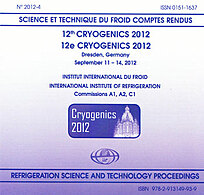
Document IIF
Avancement du système cryogénique pour l'accélérateur de particules e-lineac ARIEL chez TRIUMF.
Status of the cryogenic system for the ARIEL e-linac at TRIUMF.
Numéro : pap. n. 090
Auteurs : SITNIKOV A., BYLINSKII I., KOSCIELNIAK S., et al.
Résumé
A new cryogenic system will be installed at TRIUMF to supply liquid helium (LHe) for three accelerator cryomodules containing superconducting radio frequency (SRF) cavities operating at 2 Kelvin. The system is a part of the ARIEL e-linac particle accelerator project. The cryogenic plant is designed to provide LHe at maximum liquefaction performance of 288 l/h at 4.6 K into a supply Dewar. The transition from helium I to helium II below Lambda point (? ~ 2.17 K) occurs inside each cryomodule via Joule-Thomson expansion to sub-atmospheric pressure. The operational objective is 24/7 continuous supply of LHe during eleven months per year. This paper outlines our strategy on the configuration of the cryogenic system for different scenarios of operation and the challenges these pose; as well as the technical solutions adopted. A key ingredient for operational longevity is control of helium purity, and the gas management system is described. The paper concludes with a description of the ARIEL e-linac project status, focusing particularly on the cryogenic equipment procurement and the civil construction for the new compressor building.
Documents disponibles
Format PDF
Pages : 390-395
Disponible
Prix public
20 €
Prix membre*
Gratuit
* meilleur tarif applicable selon le type d'adhésion (voir le détail des avantages des adhésions individuelles et collectives)
Détails
- Titre original : Status of the cryogenic system for the ARIEL e-linac at TRIUMF.
- Identifiant de la fiche : 30006968
- Langues : Anglais
- Source : Cryogenics 2012. Proceedings of the 12th IIR International Conference: Dresden, Germany, September 11-14, 2012.
- Date d'édition : 11/09/2012
Liens
Voir d'autres communications du même compte rendu (78)
Voir le compte rendu de la conférence
Indexation
-
Concept design of cryogenic system for the high...
- Auteurs : GE R., MA C., ZHANG J., et al.
- Date : 08/05/2019
- Langues : Anglais
- Source : Cryogenics 2019. Proceedings of the 15th IIR International Conference: Prague, Czech Republic, April 8-11, 2019.
- Formats : PDF
Voir la fiche
-
Nitrogen cryogenic system for the future NICA a...
- Auteurs : MITROFANOVA Y., AGAPOV N., EMELIANOV N., et al.
- Date : 07/04/2014
- Langues : Anglais
- Source : Cryogenics 2014. Proceedings of the 13th IIR International Conference: Prague, Czech Republic, April 7-11, 2014.
- Formats : PDF
Voir la fiche
-
Cryogenic targets of the lightest gases (hydrog...
- Auteurs : AGAPOV N. N., BORZUNOV Y. T., KONSTANTINOV A. V., et al.
- Date : 08/05/2019
- Langues : Anglais
- Source : Cryogenics 2019. Proceedings of the 15th IIR International Conference: Prague, Czech Republic, April 8-11, 2019.
- Formats : PDF
Voir la fiche
-
Cryogenic technologies of the superconducting N...
- Auteurs : AGAPOV N., KHODZHIBAGIYAN H., KONSTANTINOV A., et al.
- Date : 08/05/2019
- Langues : Anglais
- Source : Cryogenics 2019. Proceedings of the 15th IIR International Conference: Prague, Czech Republic, April 8-11, 2019.
- Formats : PDF
Voir la fiche
-
Cryogenic plant design for Taiwan Light Source ...
- Auteurs : LIN M. C., WANG C., LUO G. H., et al.
- Date : 22/07/2002
- Langues : Anglais
- Source : Proceedings of the nineteenth International Cryogenic Engineering Conference. ICEC 19.
Voir la fiche
